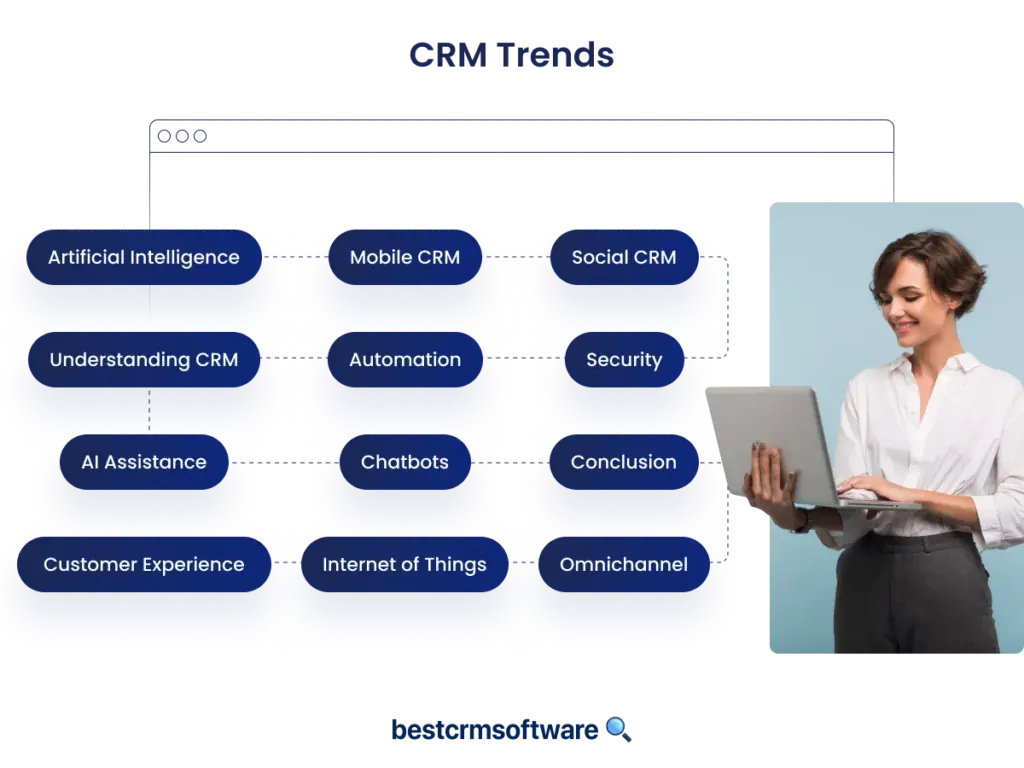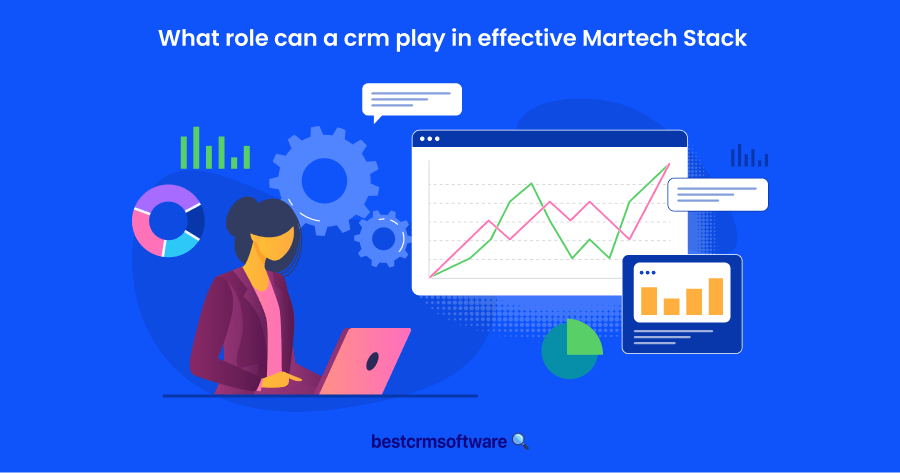
CRM Trends: Key Strategies to Stay Ahead
In a Nutshell
Get ahead of the curve with our exclusive insights into the forthcoming low code CRM trends of 2024. As a CRM consultant, my shortlist provides a glimpse into the future of CRM low code, highlighting the key trends that I think are set to redefine the industry.
2024 CRM Trends – My Handpicked Shortlist
- Intervention of Artificial Intelligence
- Sustainable Strategies Integrated into CRM Market Trends
- Cloud-Based Modern CRM Solutions
- Building Cyber Security Measures
- Augmented Reality (AR) Support
- Voice Assistants Integration
- Harnessing IoT-Driven Insights
- Advanced Reporting and Analytics
- New Age Data Visualization
- Mobile CRM Being Made Accessible
As a CRM manager, I’ve noticed that by adopting these trends and integrating them into your business’ CRM strategies, you can enhance customer relationships, improve efficiency, and drive growth. As technology continues to advance and customer expectations evolve, businesses must adapt and embrace these CRM trends to stay ahead in the ever-changing landscape of customer relationship management.
Intervention of Artificial Intelligence
AI technology is revolutionizing CRM by offering advanced capabilities and enhanced analytics that provide valuable insights into customer behavior, preferences, and trends. AI-enabled low-code CRM systems can automatically analyze vast amounts of customer data, including purchase history, browsing patterns, social media interactions, and customer feedback without user coding knowledge.
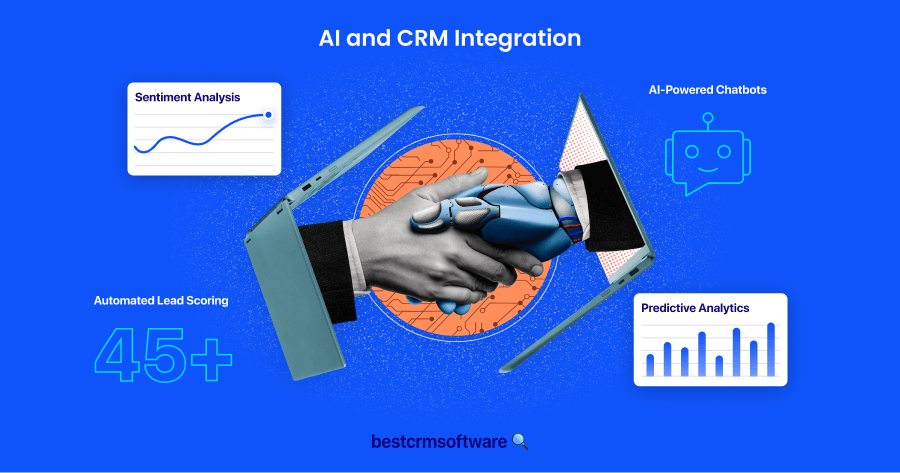
One of the key benefits of AI in low code CRM based solutions is its ability to automate routine tasks and processes. For instance, chatbots powered by AI can handle customer inquiries and provide 24/7 support, freeing up human agents to focus on more complex issues. AI algorithms can also automate lead scoring and segmentation, identifying high-quality leads and helping sales teams prioritize their efforts.
Another area where AI is making a significant impact in CRM is predictive analytics. By analyzing historical data and patterns, AI algorithms can predict future customer behavior. This predictive power allows businesses to anticipate customer needs, proactively offer personalized recommendations, and prevent customer attrition.
AI is also enhancing CRM through sentiment analysis. By analyzing customer interactions, AI can detect emotions, sentiments, and attitudes, providing businesses with valuable insights into customer satisfaction, preferences, and concerns. This enables companies to deliver more tailored and empathetic customer service, resulting in improved customer loyalty and retention.
Sustainable Strategies Integrated into CRM Market Trends
Sustainable CRM strategies aim to minimize the negative environmental impact of CRM activities while fostering positive social and economic outcomes. By integrating sustainable practices into CRM, businesses can not only enhance their brand reputation but also contribute to a more sustainable future.
One way sustainable strategies are integrated into CRM is through the adoption of green technologies. This involves using energy-efficient hardware, implementing cloud-based CRM systems to reduce the need for physical infrastructure, and leveraging renewable energy sources to power CRM operations.
Another aspect of sustainable CRM is promoting ethical sourcing and responsible supply chain management. Businesses are increasingly mindful of their suppliers’ environmental and social impact and strive to collaborate with suppliers who adhere to sustainable practices. By ensuring their CRM activities are backed by ethically sourced products and responsible supply chains, businesses can demonstrate their commitment to sustainable values and gain the trust of environmentally conscious customers.
Furthermore, sustainable CRM strategies also focus on fostering positive social impact. This involves actively engaging with local communities, promoting diversity and inclusion, and supporting social causes through CRM activities.
Businesses are also integrating sustainability into the customer experience. This can include offering eco-friendly product options, promoting recycling and waste reduction, and incentivizing customers to choose sustainable options. Businesses are increasingly disclosing their sustainability efforts and achievements to demonstrate accountability and build trust with customers. This can be done through sustainability reports, labels, and certifications that provide customers with visibility into the environmental and social impact of the products or services they are purchasing.
Cloud-Based Modern CRM Solutions
Cloud-based modern CRM solutions refer to CRM software that’s hosted and accessed on the cloud instead of being installed on local servers or computers. This trend has gained significant popularity in recent years due to its numerous advantages over traditional on-premise CRM systems.
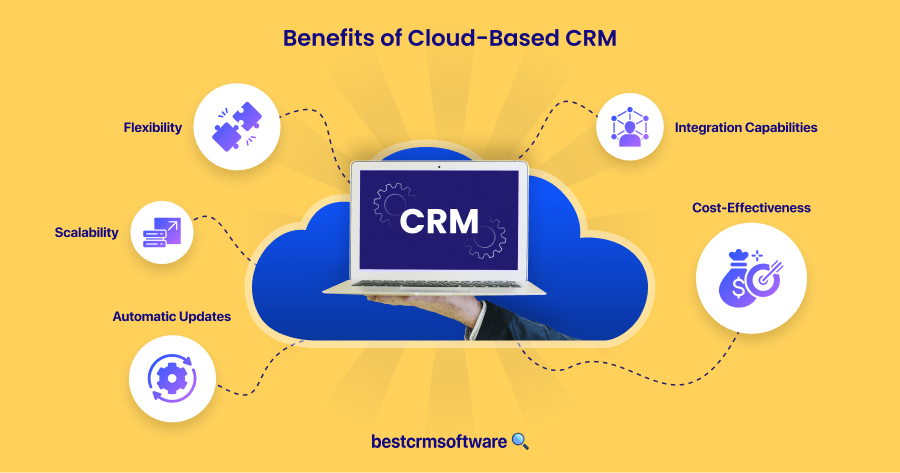
One of the major benefits of cloud-based CRM solutions is the flexibility and scalability they offer. Since the software is hosted on the cloud, it can be accessed from anywhere and at any time, as long as there is an internet connection. Additionally, cloud-based CRM solutions can easily scale as businesses grow, allowing for seamless expansion without the need for additional infrastructure investments.
Another advantage of cloud-based CRM solutions is their cost-effectiveness. This means that businesses pay a monthly or annual fee based on the number of users and features they require. By eliminating the upfront costs and ongoing maintenance expenses, cloud-based CRM solutions are more affordable and suitable for businesses of all sizes, including startups and small businesses.
Integration capabilities are another key feature of cloud-based modern CRM solutions. These solutions often provide APIs (Application Programming Interfaces) and integrations with other business software and tools, such as email marketing platforms, help desk software, accounting systems, and e-commerce platforms. This allows businesses to streamline their operations, automate processes, and have a centralized view of customer interactions.
Since the software is hosted on the cloud, updates and new features can be deployed seamlessly without disrupting the users. This ensures that businesses always have access to the latest functionalities and technologies, enabling them to stay ahead of the competition and adapt to changing customer needs and market trends.
Building Cyber Security Measures
Building cybersecurity measures within CRM systems is a crucial trend in the digital age to safeguard sensitive customer data and maintain trust with clients. Let’s look at the importance and key aspects of integrating cybersecurity measures into CRM systems.
- Data Protection: Implementing encryption techniques, access controls, and user authentication mechanisms can help ensure that sensitive information stored in the CRM system is secured against cyber threats.
- Compliance and Regulations: Essential for businesses handling customer data. Regulations such as GDPR, HIPAA, and PCI DSS have stringent guidelines for data protection and privacy. CRM systems should be designed to comply with these regulations to avoid penalties and maintain customer trust.
- Vulnerability Assessment and Patch Management: Identify and address security vulnerabilities within CRM systems. By staying proactive in identifying and mitigating potential security risks, businesses can prevent cyber-attacks and data breaches that may compromise customer data.
- Training and Awareness: Include training programs to educate employees about potential security threats, best practices for handling customer data, and how to recognize and respond to security incidents. Employee awareness and vigilance help mitigate risks.
- Incident Response and Recovery: These plans outline procedures for containing the breach, assessing the impact, notifying stakeholders, and initiating recovery measures to restore CRM system functionality while minimizing disruptions.
- Integration with Security Tools: Intrusion detection systems, security information and event management (SIEM) solutions, and endpoint protection platforms enhance the overall security posture of the system.
- Continuous Monitoring and Auditing: Detects anomalies and suspicious activities that may indicate potential security incidents. Regular security audits and penetration testing can identify vulnerabilities and gaps in cybersecurity measures.
- Vendor Security Assessment: Evaluating the vendor’s security policies, data encryption practices, disaster recovery protocols, and compliance certifications can help organizations select a reliable and secure CRM system.
Augmented Reality (AR) Support
AR support in CRM brings several benefits to businesses. It can provide an immersive and interactive experience for customers, enabling them to visualize products or services in their own environment before making a purchase. This interactive element enhances customer engagement and creates a memorable experience, which in turn can lead to increased customer satisfaction and loyalty.
One key advantage of AR support is its ability to enhance customer support and troubleshooting processes. By integrating AR technology into CRM systems, businesses can provide real-time assistance and guidance to customers remotely. For instance, customers can use their smartphones or AR devices to show the product or issue they’re facing, and support agents can overlay digital instructions or annotations onto the live video feed.
AR support also has applications in sales and marketing. Businesses can utilize AR to create virtual showrooms or product catalogs, allowing customers to visualize and interact with products before making a purchase. This technology can be particularly valuable for industries such as interior design, home improvement, or fashion, where visualizing the end product is crucial for customers.
Furthermore, AR support can enhance the effectiveness of marketing campaigns. Businesses can create interactive AR experiences, such as gamified promotions or virtual try-ons, to captivate and engage their target audience. By leveraging AR, businesses can offer a unique and personalized marketing experience, increasing brand awareness and driving customer acquisition.
Implementing AR support in CRM requires integration with existing systems and infrastructure. This may involve developing or utilizing AR applications and platforms, ensuring compatibility with different devices and operating systems, and integrating AR data and analytics with CRM databases.
AR support in CRM is still an emerging trend, and businesses need to consider certain challenges. The technology may require initial investment in hardware and software development, as well as staff training to effectively utilize and support AR solutions. Additionally, privacy concerns and data security should be addressed to ensure customer information is safeguarded.
Voice Assistants Integration
Voice assistants, such as Amazon’s Alexa, Apple’s Siri, Google Assistant, and Microsoft’s Cortana, have gained widespread adoption, and integrating them with CRM systems opens up new opportunities for improving customer engagement and streamlining processes. Automation uses voice technology to automate routine customer interactions and processes, reducing the burden on support teams and improving response times.
One key benefit is enhanced customer convenience. Voice technology allows customers to interact with businesses using natural language commands. This eliminates the need for typing or navigating through websites or applications. With voice assistants, customers can quickly inquire about product details, check their account status, place orders, or get support, all through simple voice commands.
Moreover, voice assistant integration enables businesses to offer personalized and context-aware experiences. Voice assistants can be integrated with CRM systems to access customer data and provide tailored recommendations or suggestions. For example, a customer calling a voice assistant for support can receive relevant information based on their purchase history or preferences, leading to a more personalized and efficient resolution of their issue.
Voice assistants also have potential applications in sales and marketing. Businesses can leverage voice technology to deliver targeted promotions or offers to customers, either through proactive voice notifications or by integrating voice assistants into the sales process. By using voice assistants for lead generation, businesses can capture customer information, qualify leads, and gather valuable insights into customer preferences and behavior.
Implementing voice assistant integration in CRM may involve developing voice-enabled applications or skills, ensuring seamless integration with CRM databases and analytics tools, and optimizing for different voice assistant platforms. Considerations for multi-language support, voice recognition accuracy, and security measures should also be taken into account.
While voice assistant integration in CRM holds significant potential, businesses need to address certain challenges. Voice technology is still evolving, and businesses must stay updated with advancements and ensure compatibility with the latest voice assistant features and capabilities.
Harnessing IoT-Driven Insights
The Internet of Things (IoT) refers to a network of interconnected devices that can exchange data over the Internet. These devices include smartphones, tablets, wearable devices, household appliances, vehicles, and industrial machinery.
Using IoT devices in CRM allows companies to gather vast amounts of data that can provide valuable insights into customer behavior, preferences, and needs. By analyzing this data, businesses can better understand their customers and deliver personalized experiences and targeted marketing messages. Here are some key aspects of harnessing IoT-driven insights in CRM:
- Customer understanding: By analyzing data, companies can gain a deeper understanding of their customers’ preferences, habits, forex, and needs. For example, a retailer could use IoT devices to implement low code forex CRM to track customers’ movements and gather data on areas that attract the most attention.
- Personalization: IoT-driven insights enable companies to deliver personalized experiences to their customers. By combining data from IoT devices with customer profiles and historical data, businesses can offer tailored recommendations, product suggestions, and promotional offers. For example, a fitness brand could use data from a customer’s wearable device to offer personalized workout routines or nutritional advice.
- Proactive customer service: This data can be used to detect issues or foresee problems before they occur. For example, a manufacturer of industrial equipment could use IoT sensors to monitor the performance of their machines and detect any anomalies. This allows them to proactively schedule maintenance or address potential issues.
- Predictive analytics: By analyzing historical IoT data and customer interactions, businesses can identify patterns and trends that can inform their decision-making processes. This can be particularly useful in forecasting demand, optimizing inventory management, and improving supply chain logistics.
- Data security and privacy: Companies must ensure robust security measures to protect information from unauthorized access or breaches. Compliance with data protection regulations, such as GDPR, is crucial to maintaining customer trust and transparency.
Advanced Reporting and Analytics
This trend involves the use of sophisticated tools and techniques to collect, process, and analyze large volumes of data, enabling organizations to derive valuable insights and make data-driven decisions. Here are the key aspects of advanced reporting and analytics in CRM:
- Data-driven decision-making: By analyzing customer interactions, purchase history, demographic information, and other relevant data points, organizations gain a deep understanding of customer behavior, preferences, and trends. This enables them to tailor marketing strategies, product offerings, and customer service initiatives to better meet customer needs.
- Performance measurement: By tracking key metrics such as customer acquisition costs, customer lifetime value, sales conversion rates, and customer satisfaction scores, organizations can assess the effectiveness of their strategies and make adjustments to improve results.
- Predictive analytics: Advanced reporting and analytics enable businesses to move beyond historical data and leverage predictive modeling techniques to anticipate future customer behavior and market trends. By using machine learning algorithms and predictive models, organizations can forecast customer churn, identify cross-selling and upselling opportunities, and optimize pricing strategies.
- Customer segmentation and personalization: Advanced analytics tools allow businesses to segment their customer base into distinct groups based on various criteria such as demographics, purchasing behavior, and engagement levels. This segmentation enables organizations to deliver targeted marketing messages, personalized recommendations, and tailored offers to different customer segments.
- Real-time insights: This real-time visibility allows organizations to respond swiftly to changing trends, monitor the impact of new marketing initiatives, and address customer issues promptly. Real-time reporting and analytics empower businesses to be agile and adaptive in their customer-focused strategies.
- Integration with other business systems: By consolidating data from different business units and systems, organizations can gain a comprehensive view of their customers and their interactions with the company. This integrated approach enables a holistic understanding of customer journeys and touchpoints.
New Age Data Visualization
New Age Data Visualization refers to the process of transforming complex data into interactive and visually appealing graphics. This kind of visualization can help companies to identify patterns, trends, and insights that may not be noticeable in complex spreadsheets and tables.
This trend is important because of the rapidly increasing amount of data generated every day. Companies need to use sophisticated analytics and visualization tools to derive insights from their data quickly and efficiently. Some of the benefits of New Age Data Visualization include:
- Enhanced decision-making
- Increased efficiency
- Improved collaboration
Mobile CRM Being Made Accessible
Mobile CRM refers to the ability to access and manage customer information, sales processes, and other CRM functionalities through mobile devices. Traditionally, CRM systems were primarily built for desktop usage, limiting access to critical customer data and features to office environments. However, with the advent of mobile CRM, users can now access their low code CRM platform anytime, from anywhere. There are several reasons why mobile CRM accessibility is a vital trend:
- Increasing productivity: Sales representatives can access customer information, update records, and manage their sales pipelines on the go. This ensures that they can make timely decisions and respond quickly to customer needs, ultimately improving overall productivity.
- Enhanced customer service: Sales or support teams can quickly access customer information, view previous interactions, and provide personalized experiences, leading to higher customer satisfaction.
- Real-time collaboration: Whether updating lead status, sharing notes about a customer meeting, or assigning tasks, real-time collaboration ensures that everyone has the latest information and can work together seamlessly.
- Improved data accuracy: With the ability to update information immediately after a customer interaction, users can ensure that all data is accurate and up-to-date. This enhances the overall quality of customer data and enables better decision-making.
To address this trend, CRM providers are investing in developing mobile applications that offer similar functionalities and user experiences as their desktop counterparts. These applications are optimized for smaller screens and touch interactions, making them convenient and user-friendly.
Upcoming Trends and Predictions on CRM
One of the upcoming trends and predictions in CRM is the emphasis on the omnichannel experience. As technology advances and customer expectations evolve, businesses are recognizing the importance of providing a seamless and integrated experience across multiple channels.
The omnichannel experience refers to the integration of various communication channels, such as email, phone, social media, and chat, into a unified customer experience. It allows customers to interact with businesses through their preferred channels and seamlessly switch between channels without losing context. For example, a customer may start a conversation with a business on social media and then continue the conversation via email or phone without having to repeat information.
Another trend in CRM is the emergence of industry-specific CRM solutions tailored for Small and Medium-sized Businesses (SMBs). While CRM systems have traditionally been associated with larger enterprises, the demand for CRM solutions among SMBs is growing. However, SMBs often have unique requirements and limited resources, making it crucial for CRM solutions to address their specific needs.
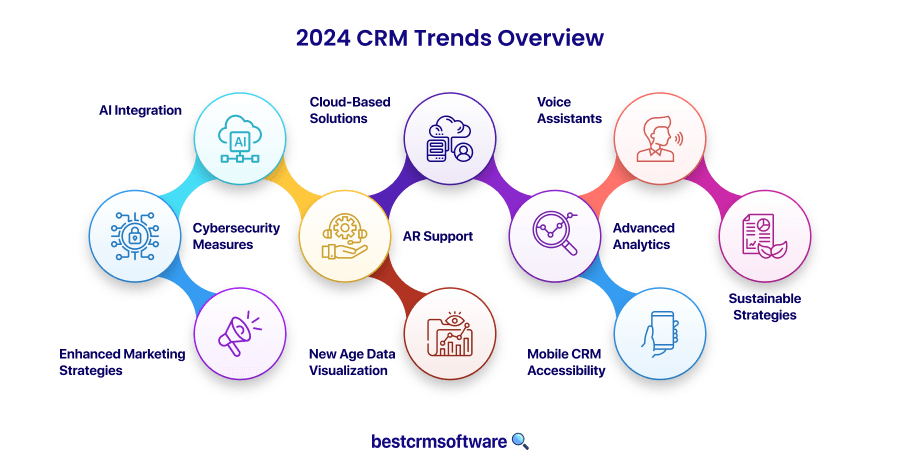
Conclusion
The world of CRM is constantly improving, and staying abreast of the latest trends is essential for businesses to remain competitive. This blog has explored some of the key CRM trends that are shaping the industry today, including the importance of customer experience, the rise of AI and automation, the shift towards mobile CRM, and the increasing emphasis on data analytics and personalization.
Explore our other blogs too! Our CRM experts publish helpful content daily, covering everything from how-to guides to in-depth articles on CRM adoption.


